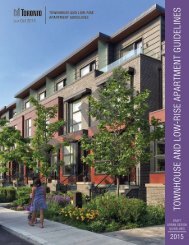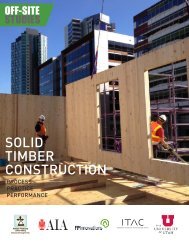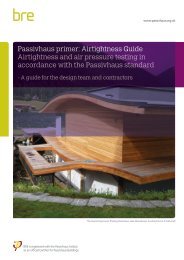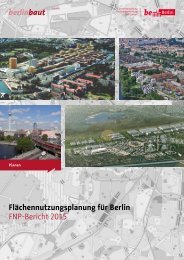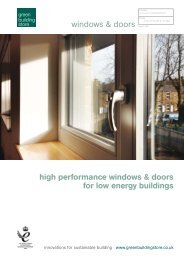TRUE URBAN SPIRIT
b008379b
b008379b
You also want an ePaper? Increase the reach of your titles
YUMPU automatically turns print PDFs into web optimized ePapers that Google loves.
DIVERSIFIED MOBILITY IN 2025<br />
4.1<br />
FOCUS<br />
MOBILITY IN THE<br />
GROWING CITY<br />
The growing city results in heavier<br />
traffic loads. While car traffic in the<br />
central districts is stagnating, public<br />
transport networks as well as cycling<br />
infrastructure facilities are sometimes<br />
already used to capacity and beyond.<br />
Permanent overload looms unless<br />
proactive measures are taken. If the<br />
currently positive trend in mobility<br />
behaviour continues, further investments<br />
in eco-friendly means of transport<br />
(public transport, walking and<br />
cyc ling). are called for. In addition to<br />
the stepping-up of the infrastructure<br />
system, it is also important to preserve<br />
and improve existing qualities.<br />
MODAL SPLIT IN<br />
COMMUTER TRAFFIC<br />
As a prospering economic hub, Vienna<br />
is an attractive place to study and work<br />
for hundreds of thousands of people<br />
from the entire eastern part of Austria<br />
and beyond; at the same time, more and<br />
more Viennese are working in the metropolitan<br />
region, beyond Vienna’s city<br />
limits. At the moment, traffic across<br />
municipal boundaries between Vienna<br />
and its environs is still dominated by<br />
cars with a mode share of 79 percent. In<br />
this respect, the situation is especially<br />
problematic along Vienna’s southern<br />
boundary, which is crossed by 220,000<br />
vehicles in both directions, day after day.<br />
MULTIMODALITY<br />
DA–IK<br />
To support everyday multimodality<br />
corresponding infrastructure must be<br />
provided. In particular, high-level<br />
public transport nodes are currently not<br />
well prepared for intermodal traffic<br />
( Intermodality). Rendering the<br />
possibili ties to switch between walking,<br />
(rental) bikes, e-mobility, car sharing,<br />
(e-) taxis and public transport more<br />
attractive provides a key stimulus for<br />
increasing the share of eco-friendly<br />
means of transport in the total number<br />
of trips taken in the city.<br />
ATTAINMENT OF ENVIRONMENTAL<br />
AND CLIMATE PROTECTION GOALS<br />
Despite measurable changes in mobility<br />
behaviour, significant pollutant loads<br />
still do occur. Often the reasons for this<br />
cannot be directly influenced or eliminated<br />
by the City of Vienna. Despite this,<br />
municipal mobility policies must also<br />
be conceived of as a key element of the<br />
city’s climate protection strategy.<br />
STREETSCAPE DESIGN<br />
At the moment, streetscape design<br />
reflects changes in mobility behaviour<br />
and the manifold types of use of public<br />
space only insufficiently: approx. 65<br />
percent of the road surface is still taken<br />
up by stationary and moving traffic.<br />
The prioritisation of eco-friendly means<br />
of transport is not yet adequately expressed<br />
in streetscape design.<br />
103



